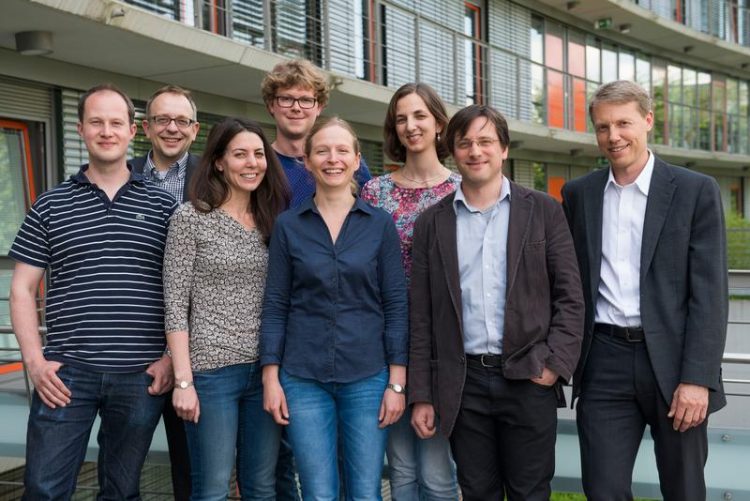The Achilles’ heel of HI virus

The team: Dr. Thomas Zillinger, Dr. Christoph Coch, Eva Bartok, Steven Wolter, Dr. Anna-Maria Herzner, Dr. Marion Goldeck, Dr. Martin Schlee and Prof. Dr. Gunther Hartmann. © Foto: Rolf Müller/UKB
The first line of defense of the immune system against pathogens is innate immunity. It is based on specialized sensor proteins, the receptors. These receptors detect foreign structures, for example, cell wall components of bacteria or also the genetic material of viruses. A cellular molecule known as cGAS acts as a genetic material sensor.
When cGAS detects viral DNA, the sensor immediately sounds the alarm. A cascade begins during which the immune system is activated and the cell and its neighbors arm themselves against the viral infection. Scientists at the University of Bonn Hospital have played major roles in earlier works on the exact description of this cascade.
The DNA of many viruses is double-stranded: It consists of two threads wound around each other like two cables twisted together. To date, it has been thought that cGAS can only identify such double-stranded DNA. By contrast, the genetic material of retroviruses such as HIV-1 consists of RNA.
RNA is closely related to DNA, however it is always single-stranded in retroviruses. If retroviruses multiply in human cells, the RNA is “transcribed” into DNA. But this is then also single-stranded. It was an equally large surprise to discover that cGAS is also activated by the HI virus 1.
Twisted DNA
Various working groups have recently provided the first step towards an explanation: They were able to show that single-stranded DNA can form what are known as “hairpin” structures – similar to how a single cable can twist around itself so that it resembles two cables twisted around each other. DNA structures of this type thus form short double strands and these are detected by the cGAS sensor.
“The hairpin structures which can form in the case of HIV-1 are actually too short to be detected by cGAS,” says Dr. Martin Schlee. The researcher from the Institute of Clinical Chemistry and Clinical Pharmacology at the University of Bonn Hospital is the senior author of the study.
Together with cooperative partners from Bonn, Munich and Erlangen, his working group was now able to show why it nonetheless worked: in addition to the short, double-stranded piece, cGAS also detects special building blocks in the non-twisted, single-stranded piece, known as guanosines. As a result, the cellular response is significantly increased.
“If we remove the guanosines from these structures, the cell can no longer react to the single-stranded DNA,” explains lead author Anna-Maria Herzner. “By contrast, if we add in additional guanosines, cells react more strongly.”
How HIV-1 viruses circumvent the immune system
Interestingly, the DNA which develops during the HIV-1 infection is particularly lacking guanosines. “HIV-1 viruses appear to have been selected by the immune system to eliminate guanosines from their DNA,” says Prof. Dr. Gunther Hartmann, Director of the Institute of Clinical Chemistry and Clinical Pharmacology as well as spokesperson of the ImmunoSensation excellence cluster. “They may thus be able to partially avoid discovery by the cell.”
A new work from the Massachusetts Institute of Technology (MIT) in Boston shows that this DNA detection is actually of major clinical significance. There are people infected with HIV-1 who suppress the virus so well that it can no longer be detected. Certain immune cells of these so-called “elite controllers” accumulate so much HI virus DNA that they can nonetheless be detected – possibly via the guanosines that still remain.
They trigger such a strong immune response that the virus is permanently suppressed. Thus the HIV-1 genetic material appears to also be detected in these immune cells via the mechanism discovered by Dr. Martin Schlee and colleagues.
The participating researchers from Bonn are members of the DFG-funded ImmunoSensation excellence cluster. They additionally work closely together in the German Center for Infection Research (DZIF).
Publication: Sequence-specific activation of the DNA sensor cGAS by Y-form DNA structures as found in primary HIV-1 cDNA; Nature Immunology; doi: 10.1038/ni.3267
Media contact information:
Dr. rer. nat. Martin Schlee
Institute of Clinical Chemistry and Clinical Pharmacology
of the University of Bonn Hospital
Tel. ++49-(0)228-28751148
E-Mail: Martin.Schlee@uni-bonn.de
Media Contact
More Information:
http://www.uni-bonn.de/All latest news from the category: Health and Medicine
This subject area encompasses research and studies in the field of human medicine.
Among the wide-ranging list of topics covered here are anesthesiology, anatomy, surgery, human genetics, hygiene and environmental medicine, internal medicine, neurology, pharmacology, physiology, urology and dental medicine.
Newest articles

Silicon Carbide Innovation Alliance to drive industrial-scale semiconductor work
Known for its ability to withstand extreme environments and high voltages, silicon carbide (SiC) is a semiconducting material made up of silicon and carbon atoms arranged into crystals that is…

New SPECT/CT technique shows impressive biomarker identification
…offers increased access for prostate cancer patients. A novel SPECT/CT acquisition method can accurately detect radiopharmaceutical biodistribution in a convenient manner for prostate cancer patients, opening the door for more…

How 3D printers can give robots a soft touch
Soft skin coverings and touch sensors have emerged as a promising feature for robots that are both safer and more intuitive for human interaction, but they are expensive and difficult…





















